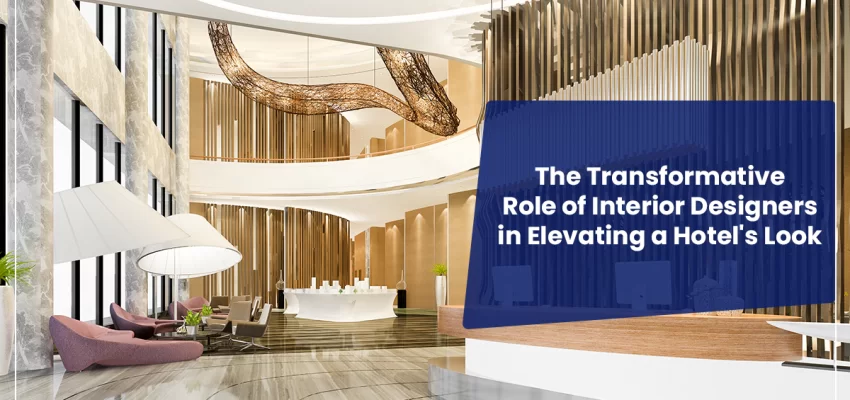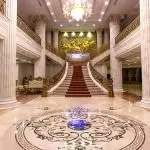Hotel interior design significantly impacts the guest experience, brand image, and overall appeal. It’s not just about aesthetics but also about attracting the right audience, conveying your brand’s promise, and showcasing your hotel’s offerings. Even small changes can have a profound impact on your property. Read our blog to understand how to create a memorable stay for your guests.
Post your Requirement
Why Hotel Interior Design Matters?
Hotel interior design plays a pivotal role in shaping the overall guest experience and contributing to a hotel’s success. The significance of a thoughtfully designed interior extends beyond aesthetics, influencing various aspects that directly impact the business.
Firstly, a well-designed interior has the power to attract your ideal guests. The ambiance, decor, and overall atmosphere created by interior design play a crucial role in making guests feel comfortable and welcome. This positive experience encourages repeat visits, fostering guest loyalty.
Furthermore, effective hotel interior design serves as a platform to showcase your hotel’s best features. Whether it’s unique architectural elements, stunning views, or luxurious amenities, a well-designed space brings these aspects to the forefront, creating a lasting impression on guests.
In a competitive hospitality industry, standing out is essential. Hotel interiors that are distinct and memorable set your establishment apart from competitors. This distinctiveness not only attracts guests but also captures the attention of event planners looking for unique venues.
Speaking of events, a well-designed hotel interior can attract event planners seeking visually appealing and functional spaces. This opens up additional revenue streams for the hotel through hosting various events, conferences, and functions.
Local recognition is another benefit derived from thoughtful interior design. A visually appealing and well-designed hotel becomes a landmark in the community, gaining acknowledgment and positive reviews from locals.
Crucially, interior design serves as a medium to express your brand promise. It communicates the values, identity, and unique selling points of your hotel. The design elements, color schemes, and overall aesthetic contribute to forming a cohesive brand image.
In essence, hotel interior design is not just about creating visually appealing spaces; it’s a strategic investment that attracts the right guests, sets you apart in a competitive market, and communicates your brand identity effectively.
Foundational Principles of Interior Design
Here are some foundational principles of interior design explained:
- Color: The colors used in a space impact how people feel. They set the mood and atmosphere of the room.
- Space: This refers to the overall size of the area and how furniture and empty spaces interact within it.
- Texture: Texture adds depth and interest to a room. It’s found in various elements like walls, furniture, and decor items.
- Pattern: Patterns, like texture, can greatly influence the room’s overall feel and style.
- Lines: Lines guide the eye and provide direction in a space. They can be horizontal, vertical, or dynamic, as seen in elements like furniture and architectural features.
- Light: Light, whether natural or artificial, creates a mood and helps transition a space from morning to night.
- Form: Form refers to the overall shape of a space and the objects within it, defining its general structure and layout.
Hotel Interior Designing Tips
Here we have stated some of the interior design tips from industry experts:
- Find Your Focus: Before you start designing, think about your core audience and brand promise. Ensure your design reflects your hotel’s unique identity, attracting the right guests who share your vision. Hotel de Nell in Paris, for instance, offers a “home away from home” experience, which is evident in its interior design.
- Use Color Psychology: Choose colors carefully based on how they affect mood. Cool colors like blue and green promote relaxation, while small accents of yellow can stimulate conversation. Keep in mind that light colors make spaces feel brighter and open, while dark colors add sophistication and intimacy.
- Balance Form and Function: Beautiful design should never sacrifice usability. Ensure all room features are easy to understand and use. This applies to public spaces too. Make seating comfortable, ensure clear signage, and select durable flooring for high-traffic areas.
- Get Inspired by Your Location: Incorporate local elements into your design to connect with the community and give guests a sense of place. For instance, Ambiente in Sedona embraces a sustainable, eco-friendly focus that complements the surrounding natural beauty.
- Design for the Future: Make room designs last by keeping essential elements simple and timeless. Use smaller, changeable items to reflect current trends. Seek guest feedback and adapt designs accordingly.
- Highlight Local Art: Showcase local artists to connect with the community. Consider placing art in the lobby, dining areas, and guest rooms. You can even offer the art for sale to guests, creating a unique experience.
- Blend with Surroundings: Design spaces that seamlessly merge indoor and outdoor areas, taking inspiration from the natural surroundings. The Bulgari Resort in Dubai is an excellent example of this approach.
- Pay Attention to Lighting: Lighting affects both aesthetics and guest experience. The right lighting creates a relaxed atmosphere, while the wrong choice can add stress. Corinthia London uses lighting, like a massive crystal chandelier, to create a stunning visual impact.
- Focus on Transitions: Don’t overlook transitional areas. Provide clear signage and appropriate lighting to guide guests seamlessly from one space to another. Transitions should make sense and prepare guests for what’s next.
- Seek Professional Help: When it comes to interior design, it’s essential to hire experienced professionals who understand your brand, goals, and location. A skilled interior designer will bring your ideas to life and create an aesthetically pleasing space that aligns with your vision.
To keep your hotel up-to-date and competitive, stay tuned to the industry trends in technology and design. This helps ensure your property meets customer expectations and remains modern, as there’s no universal formula for modernization.
Also Read: 10 Benefits of Hiring An Interior Designer
FAQs
Q-1. How do interior designers improve guest comfort in hotel rooms?
A-1. They choose comfy furniture, calming colors, and practical layouts.
Q-2. How can hotel owners benefit from hiring interior designers?
A-2. Interior designers ensure guest satisfaction, and repeat bookings, and ultimately boost hotel revenue.
Q-3. What are the factors to consider in hotel interior design?
A-3. When designing hotel interiors, factors like functionality, guest comfort, aesthetics, durability, and budget adherence are crucial to creating appealing and practical spaces that meet guest expectations.























Post A Comment